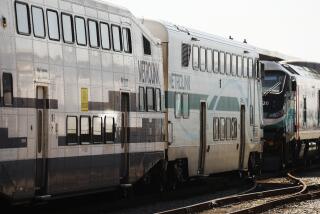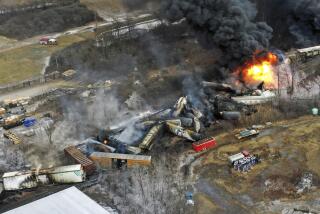Investigators focus on whether signal was broken or missed
Federal officials investigating Friday’s fatal Metrolink train crash focused Sunday on whether a signal that should have alerted the engineer to stop the train was working properly, and whether it went unheeded.
National Transportation Safety Board member Kitty Higgins said a computer reading indicated the last signal before the collision site was displaying a red light. But she said investigators wanted to make sure it wasn’t a false reading.
Higgins criticized Metrolink for saying Saturday that an engineer had been at fault for failing to heed the red signal, causing the crash with a Union Pacific freight train that so far has claimed 25 lives and left 135 injured, 40 critically.
“I don’t know on what basis Metrolink made that statement. We really work very hard not to jump to conclusions,” Higgins said at a Sunday news conference in Woodland Hills.
The conflict between the agencies surfaced as authorities pulled apart the wreckage in an attempt to clear the tracks in Chatsworth and restore service by this evening, and hundreds of grieving friends and relatives of the dead gathered to pray in Simi Valley, the train’s destination.
The train passed four signals between De Soto Avenue and Nashville Street that, if working correctly, would have flashed yellow or red to warn the engineer to slow and stop.
The engineer, stationed at the front of the train, and conductor, stationed at the back, customarily call each other to repeat signals seen by the engineer, Higgins said. Officials have listened to recordings and found no indication that the engineer and conductor exchanged information on the last two signals, one of which should have been flashing yellow and the other red. The investigators were unsure whether “dead zones” might have interfered with such communication.
Higgins also disclosed that the Metrolink train “blew through” a switch controlling a junction with a railroad siding closest to the accident site. A data recorder said the Metrolink train was traveling at 42 mph when it passed the switch.
NTSB officials have interviewed a Metrolink dispatcher based in Pomona who said he had set up the signals and the switch so that the Union Pacific freighter and the Metrolink train could pass without incident. But Higgins disputed a Metrolink assertion that the dispatcher had tried to contact the train about a potential collision course, a message that allegedly arrived too late.
“By the time the dispatcher realized there was something wrong, the accident had already occurred,” Higgins said. She added that the conductor, who was seriously injured, called the dispatcher to notify him of the accident. The conductor had not been interviewed by her agency, she added.
A Metrolink spokesman earlier Sunday gave a different account, saying that a Metrolink dispatcher had been alerted to the potential crash by a computer signal and tried to warn the engineer that he was about to collide with a freight train. The spokesman said the dispatcher reached the conductor after the crash had occurred.
Metrolink officials said they expected regular service on the Los Angeles-Ventura County line to resume in time for evening rush hour today and made plans to ferry passengers by bus between Ventura County and Chatsworth until then.
Regular riders on the route said the Metrolink train heading toward Simi Valley often stopped at the junction to wait for a Union Pacific freight train headed toward downtown Los Angeles to switch to the siding.
There are four signals leading up to the crash site: at De Soto Avenue, where the siding begins; at Lassen Street; at the platform at the Chatsworth station; and near Nashville Street, where the siding converges with the main line again.
If they were functioning properly, the early signals would have been yellow or red and the final one, red.
Higgins said investigators are awaiting toxicology reports on the engineer, which should be available in two to three weeks.
A union representing 125,000 rail workers -- though not those who work for Metrolink -- on Sunday said Metrolink’s decision to blame the engineer was “terribly premature.”
A union spokesman noted that the engineer, who died in the crash, might have been disabled by a heart attack or stroke. The engineer had at least 10 years of experience. He had worked for Amtrak and more recently for a private firm, Veolia Transportation, that provides Metrolink with engineers. The Simi Valley-bound Metrolink train he drove Friday was carrying 225 passengers when it collided with the Union Pacific freight train descending into the San Fernando Valley.
Authorities Sunday also released the names of two previously unidentified victims: Ronald G. Grace, 55, and Roger Spacey, 60, both of Simi Valley.
With NTSB investigators looking on late Sunday afternoon, a Metrolink locomotive towed away two passenger cars that were not severely damaged, while workers with blow torches began dismantling a severely damaged passenger car and the engine of the ill-fated train. Workers had already removed the Union Pacific freight train. Metrolink spokeswoman Denise Tyrrell said that after the wreckage was removed, the agency would have to repair about 1,000 feet of track.
Friday’s crash boosted Metrolink’s fatality record to one of the worst in the nation, records show.
But Keith Millhouse, vice chairman of Metrolink’s board of directors and a Moorpark city councilman, said “statistics don’t tell the story.” He noted that the deadliest previous crash in Metrolink history was not the line’s fault. A Los Angeles jury convicted a former Compton laborer of parking his truck on the track, triggering the 2005 wreck that killed 11 people and injured at least 180 others. Millhouse said other fatal incidents had involved suicides or trespassing cases and were not Metrolink’s fault.
He said he still had confidence in the line. “I will be on the train first thing tomorrow morning to show people I have faith in the system,” he said Sunday.
The process of identifying those killed and notifying relatives of the dead is ongoing, according to the Los Angeles County coroner’s office. By late Sunday, the names of 23 people killed in the crash had been released. Friends and relatives of the injured waited for news.
KCBS reported Saturday that several teenage train aficionados said they had received a text message from the engineer shortly before the crash. The NTSB said it was treating the report with caution, noting that similar accounts had circulated after a crash in Boston but were found to be inaccurate.
“We’ve heard reports to that effect, but we have nothing to confirm,” said Higgins of the NTSB.
A woman who identified herself as the mother of one of the teenagers, but asked that her name not be used to protect her 14-year-old son’s privacy, said that he and some of his friends often rode the Metrolink train on Friday afternoons and had become friendly with the engineer. Investigators had spoken to some of them, she said.
“They knew the engineer very well,” she said Sunday, “and they are mourning the loss of this gentleman. They all aspire to be engineers.”
Authorities have not yet identified the engineer.
But officials said he was certified specifically on the L.A.-to-Simi Valley route, his regular assignment, and was familiar with signal locations.
The Union Pacific freight train and the 3:35 p.m. Metrolink train out of Union Station routinely passed each other near Chatsworth.
About 800 people gathered Sunday night in Simi Valley for a prayer service at Grace Brethren Church. When pastors asked those with friends or relatives among the dead to stand, about one third of those in attendance rose. “We are a grieving community tonight,” said one of the pastors, Paul Kuzma of New Heart Church.
“We are a community whose hearts are crying and a community whose mind can’t wrap around the terrible things that happened.”
--
scott.glover@latimes.com
ted.rohrlich@latimes.com
Times staff writer Catherine Saillant contributed to this story from Simi Valley.
--
(BEGIN TEXT OF INFOBOX)
Alternate transportation
The Metropolitan Transportation Authority will offer buses to help commuters bridge the gap along the Metrolink route affected by Friday’s crash while authorities work to clear debris and return the track to service.
Bus service
* Starting at 5:07 a.m. today, buses will be available at the Moorpark and Simi Valley stations, departing at the same time as regularly scheduled Metrolink trains, and will take passengers to the Chatsworth station.
* Buses will operate on a reverse pattern in the evening, taking passengers from Chatsworth to Moorpark and Simi Valley.
Amtrak disruptions
Service on two Amtrak train routes is affected, pending restoration of the route:
* The Pacific Surfliner and its connecting Thruway Motorcoach service are canceled, with no alternate transportation available.
* The Coast Starlight will originate and terminate in Santa Barbara, with alternate transportation provided between Santa Barbara and Los Angeles.
Passengers are urged to check amtrak.com for updates.
Surface street closures
Topanga Canyon Boulevard will be closed between Chatsworth Street and the 118 Freeway. De Soto Avenue will be open and should be used as an alternate route. “Commuting will proceed as well as can be expected,” said Mayor Antonio Villaraigosa.
Source: Metropolitan Transportation Authority, Amtrak
More to Read
Sign up for Essential California
The most important California stories and recommendations in your inbox every morning.
You may occasionally receive promotional content from the Los Angeles Times.












